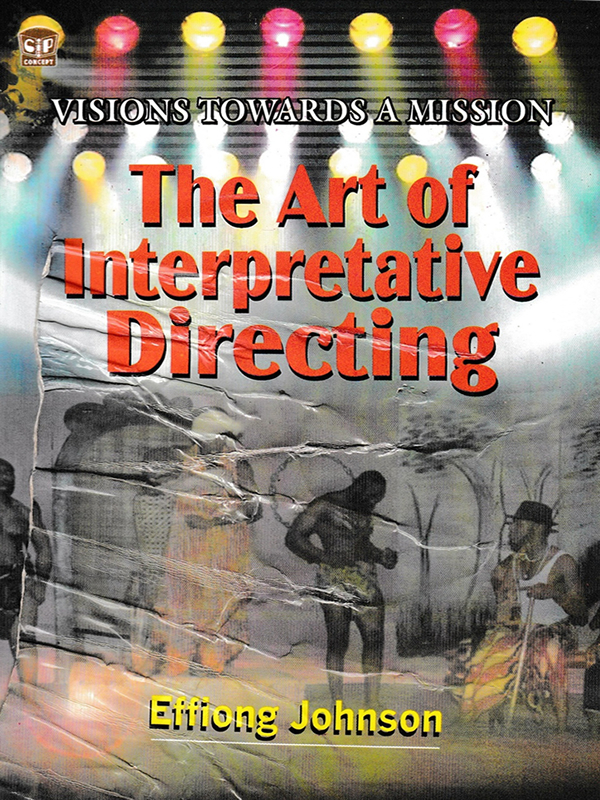Visions Towards a Mission: The Art of Interpretative Directing
$5.00
Introduction
Dr. Effiong Johnson, current Head of the Department, Theatre Arts, University of Uyo, Uyo, Akwa Ibom State of Nigeria, has become a well-known name in theatre circles. He has six published plays — Generous Donors: A Dramatic Expose on AIDS (1997), Son of the Land (2000), The Flight Has Just Begun (2000), Frogs at Noon (2001), Not Without Bones (2001), and The Stolen Manuscripts (2001).
In addition, Dr. Johnson has two pedagogic works, Playwriting: The Fundamentals (2000), and Play Production Processes (2001). Visions Towards a Mission: The Art of Interpretative Directing, which is now receiving its baptism, is his third pedagogic work.
The seven chapters of Visions Towards a Mission are very well conceived and well ordered. While chapter one deals with the large vista of visions — the society’s vision, the playwright’s vision, the director’s vision and the vision of others (theatricians, readers, and audiences, alike) — the second chapter ably tackles the background of the directorial art, and establishes substrates, and levels of meaning in directing. Types of directors, the qualities that are desirable in a director, a director’s functions, and those of his associates, are ably dealt with in this chapter.
In the remaining five chapters of Visions Towards a Mission, Dr. Johnson takes the reader through the details of the art of directing, sweetening the arduous task with charming anecdotes and jokes. Chapter three shows us a variety of directorial approach, including the author’ s own approaches which he has christened ‘The Impact-Contact Aesthetics’, and that of one of his colleagues in the Department of Theatre Arts, University of Uyo, Dr. Inih Ebong (immediate past Head of Department), which he calls ‘The Cosmo-Hume Symbiosis’.
In chapters four, five, and six, Dr. Johnson gets down to brass tacks, zeroing in on the title and the information on the blurb of the published play. The cover design, the foreword, the introduction, theme, dialogue, dramatic action, characters, ideas, tempo, mood, rhythm, suspense and tension in chapter four, and the aesthetic yardsticks of movement, the essence of pictorialism, composition, balance and picturisation in chapter five; and in chapter six, the interpreting and directing of lines for meaning and the emphasis on lines, would be found particularly challenging by the reader.
Chapter seven deals with the novel topic of ‘Directing the Audience’, and recommends post-performance discussion sessions by cast, crews and audiences. The issue of documentation is bravely tackled and the need to rescue the ideas of creative directors (who must, like all mortals, die sooner or later) from eventual disappearance through lack of proper documentation is stressed, even if slightly over-stated. The provision of “Appendix: Combating Criticisms,” with a barrage of questions the director needs to consider on the script, the stage, the actors and the audience, further arms the director to do a thorough job.
Dr. Johnson gives us a well-chosen “Glossary of Directing-Related Terms” and his “Bibliography” is relevant and up-to-date. He has a set of questions at the end of each
chapter of this new book for the diligent reader to answer. My advice is: answer those questions; you would learn a lot from doing so.
What makes Dr. Johnson’s new book on directing different from the earlier Works that have appeared is the fresh eye he brings to the analysis of the director’s tasks and the methodical way in which he states each of the tasks. No one can read Visions Towards a Mission: The Art of Interpretative Directing without emerging as a more competent director. I earnestly recommend the work to both the young and the old, to both learning professionals and those who just love the theatre.
Professor Dapo Adelugba
Department of Theatre Arts
University of Ibadan
Ibadan, Nigeria.
March 2003
Description
Contents
Introduction by Professor Dapo Adelugba
1.Visions Towards A Mission
Introduction
The Society’s Vision
The PlayWright’s Vision
The Director’s Vision
Other Visions
An Example to Follow?
Questions
2. Play Directing
A Brief Background
Directing: Substrates and Levels of Meanings
The Director: Types
The Director: Qualities
The Director: Functions
The Dirctor: His Associates
Questions
3. Directorial Approaches
Introduction
Directorial Approach: Meanings Attempted
The Slavish Approach
The Elementary Approach
The Spine Approach
The Central Metaphor
The Aesthetic Super-objective Approach
The Auteur Approach
The Sub-textualistic Aesthetics
Artaudian Environmental Approach
The Total Theatre Aesthetics
Inih Ebong’s Cosmo-Humo Symbiosis
Effiong Johnson’s Impact-Contact Aesthetics
The Directorial Challenge
Questions
4. Script Interpretation
Introduction
Now, This Notion
The Title
Information on The Blurb
The Cover Design
Foreword/Introduction
The Theme
Given Circumstances
Dialogue
Dramatic Action
Characters
Ideas
Tempo
Moods
Rhythm
Coordinate/Mix of Grills
Suspense/Tension
Questions
5. Directing Movements: Aesthetic Yardsticks
Introduction
Motivational Movement
Movement Versus Human Needs of Character
Synthesis of Movement
The Essence of Pictorialism
Composition
Emphasis
Balance
Picturisation
Questions
6. Interpreting and Directing Lines for Meanings
Introduction
Thematic/Title Lines
Message-Carrying Lines
Proverbial Lines
Rhetorical Lines
Disti-acting Lines
Repetitive Lines
Climactic Lines
Tragic / Comic / Generic Lines
Stammered Lines
Attack Lines
Explanation Lines
Critical Lines
Romantic Lines
Heroic Lines
Lines Rehearsals
Lines in Relation to Movement and Action
Final Word
Questions
7. Directing the Audience
Introduction
First Encounter?
An Old Hand?
Group Behaviour
Playing Roles
Viva-like Performance Assessment
Courtesy
Issues Affecting the Audience Versus the Director’s Intermediary Role
Publicity
Safety of Life and Property
Comfort
Entertainment
Post-Performance Courtesy
Records-keeping
Questions
Appendix: Combating Criticisms
Introduction
The Script
The Stage
The Perforiners/Actors
The Audience
A Glossary of Directing-Related Terms
Works Referred To
Index
Prof Effiong Johnson
Questions and Answers
You are not logged in
